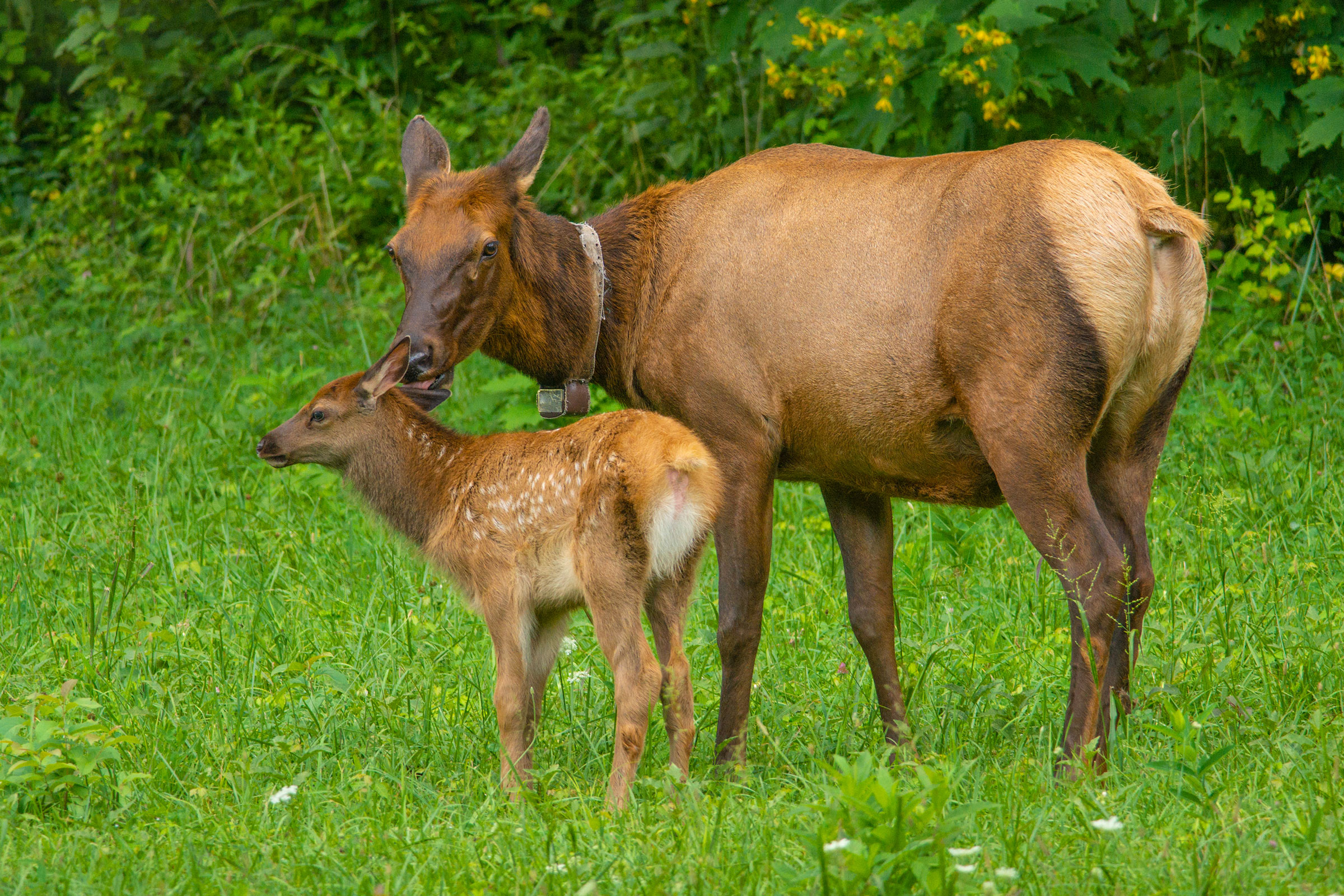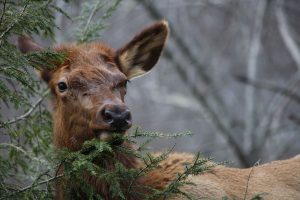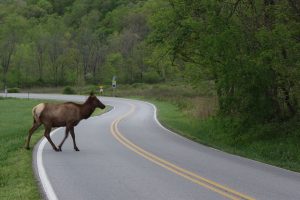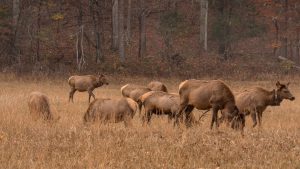
Over the decades since the transfer of 52 elk marked the reintroduction of the species to Great Smoky Mountains National Park’s Cataloochee Valley in 2001 and 2002, wildlife biologists have longed for a statistically accurate count of the population in Western North Carolina.

While one might assume that, relatively speaking, counting elk would be easier than, say, tallying rough greensnakes or rock voles, achieving an accurate, scientific population census for elk is more complicated than it seems. Elk are big (standing up to five feet tall and weighing 850 pounds or more) and like to graze open meadows, in plain view, but when they drift into the woods, they essentially vanish. Counting them has proven challenging.
To crack the conundrum, the biologists on the case elected to count elk poop, rather than the elk themselves. Adapting methods used to estimate elk populations in Oregon and elsewhere, University of Tennessee PhD candidate Jessica Braunstein designed a research project that required upwards of 50 people from the North Carolina Wildlife Resources Commission, Eastern Band of Cherokee Indians, National Park Service, and UT to spend three winters bushwhacking through impenetrable rhododendron and mountain laurel thickets along near-vertical slopes in an unrelenting quest for elk scat. Over three years, researchers surveyed more than 1,200 randomly selected transects, located not only on public lands such as GSMNP, the Blue Ridge Parkway, Pisgah National Forest, and William H. Silver Game Lands, but also on tribal lands and numerous private properties.
The collected elk scat went off to a lab for DNA analysis, which revealed important information about each sample, including which individual elk produced it and whether that elk was male or female. Braunstein used this data to estimate not only how many elk live in the Smokies but also where they live, adult survival rates, and population growth rates. That’s “really, really important” information for the wildlife professionals who manage the elk herd, said Justin McVey, district biologist for NCWRC.

Braunstein’s study concluded that, as of 2022, approximately 240 elk lived in Western North Carolina—more than quadruple the original 52. That increase comes despite an initial population dip as the newly released ungulates learned how to adapt to the challenges of their new home, such as predation from black bears.
Nearly three-quarters of the estimated elk population is female, Braunstein found, and these female elk had a much higher year-to-year survival rate than their male counterparts. Such lopsided statistics are “pretty normal,” but Braunstein was “honestly surprised to see how much higher” the survival rate was for female elk.
Several factors likely contribute to that disparity. Poachers are more likely to target bulls for illegal hunting, and male elk tend to disperse after the rut, incurring more risk than females—car collisions are a significant source of mortality for North Carolina elk. Some male elk may simply venture so far away that they leave the study area, evading detection.
Weaknesses in the data could also play a role. Three winters’ worth of sampling yielded two intervals during which statistics like survival rates could be detected. For both males and females, this rate varied significantly between the two periods, but the swing was much more dramatic for the males, with the estimated survival rate for the second period only about half that of the first period. Braunstein said the level of variability makes her hesitant to discuss those numbers yet.

“The more data you collect over time, the more it’ll help those numbers stabilize and shrink those confidence intervals,” she said. “But that’s just going to take repeated sampling.”
That’s just what NCWRC plans to do. Using the techniques learned from Braunstein’s study, the agency will continue collecting data for the next three to five years, said Brad Howard, chief of the NCWRC Wildlife Management Division. While the population estimate is the “biggest end result” of Braunstein’s research, perhaps just as important is the direction it gives the agency on how to continue monitoring the herd.
“Having that ability now certainly provides greater confidence in understanding what does the standing the elk herd look like, where is it, those kinds of important pieces of management information,” he said.
Managing elk is a complex task. The herds are spread across three jurisdictions—the park service, EBCI, and North Carolina—and because they favor fields over woods, their presence on private land can often cause problems, especially when the private land in question is an agricultural field. Many landowners have reported issues with elk interfering with agricultural operations or behaving aggressively. The NCWRC has a variety of programs in place to help mitigate these impacts, and McVey believes attitudes toward elk “have gotten better” over the last few years.

In North Carolina, the big question is when—and if—the first elk hunting permit might be issued. In preparation for a future hunt, the NCWRC adopted a rule in 2016 that removed elk from the state’s list of species of special concern and allowed for a permit-only October hunt. No permits have been issued so far, but Braunstein’s study showed that a “very limited” bull harvest would be sustainable for the current population. However, the agency may still decide to wait a while.
“When we say ‘minimal,’ at this point in time we’re talking one or two,” Howard said. “The logistical challenges of elk hunting in that general area have not and will not go away.”
Braunstein estimated that, of the 240 elk, 154 live on lands under state jurisdiction. However, many of these elk are on private land whose owners may or may not want to open their property to permitholders. Additionally, the elk are not uniformly distributed across the landscape. They stay together in distinct herds, and some herds are not large enough to survive losing any bulls to hunting.
Though the elk population is expected to continue growing, it remains to be seen how long that growth might continue. Because Western North Carolina is so heavily forested, Howard doubts the population will ever grow beyond “the several hundred range,” barring significant landscape changes in the years ahead. That means that any hunting season approved for the foreseeable future will be extremely limited—just a handful of permits, and potentially periodic rather than annual.
Trying to forecast what the future might hold for Smoky Mountain elk is like “looking through a foggy crystal ball,” said Howard. But wildlife managers at all three agencies are grateful for the new population data they have to guide them.
“These techniques were unheard of 30 years ago, and so it’s phenomenal what can be done now,” Howard said. “It’s a very exciting time.”
Subscribe to get the latest posts sent to your email.
The Great Smokies Welcome Center is located on U.S. 321 in Townsend, TN, 2 miles from the west entrance to Great Smoky Mountains National Park. Visitors can get information about things to see and do in and around the national park and shop from a wide selection of books, gifts, and other Smokies merchandise. Daily, weekly, and annual parking tags for the national park are also available.